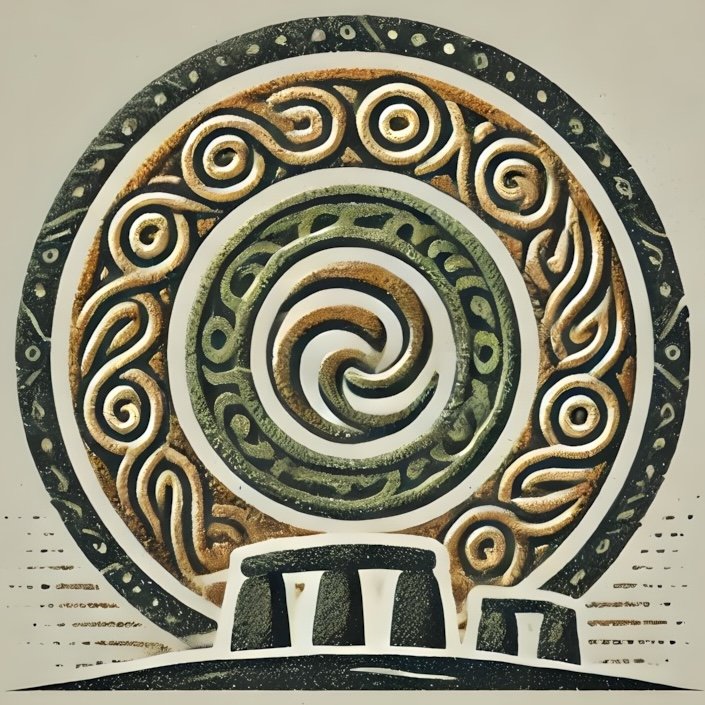Introduction to Burial Practices in Prehistoric Ireland
Burial practices in prehistoric Ireland offer a fascinating glimpse into the beliefs, customs, and social structures of ancient communities. These practices evolved significantly over millennia, reflecting changes in societal organization, technological advancements, and spiritual beliefs. The transition from Neolithic to Bronze Age Ireland marked a pivotal shift in burial customs, characterized by increasingly elaborate structures and the introduction of metalwork, particularly gold. This chapter delves into the key burial practices of the time, focusing on wedge tombs, cist burials, and the significance of goldwork within these contexts.
As we explore these burial practices, we will also highlight notable sites across the Irish landscape, allowing visitors to connect with the rich tapestry of Irish prehistory and mythology that continues to resonate today.
Wedge Tombs
Wedge tombs are one of the most distinctive burial structures found in Ireland, primarily dating from the late Neolithic to the early Bronze Age (approximately 2500-2000 BC). Characterized by their trapezoidal shape, these tombs are typically constructed from large stone slabs arranged in a wedge-like formation. The entrance is often marked by a narrow passage leading to a chamber, which would have housed the remains of the deceased.
These tombs are predominantly found in the western regions of Ireland, particularly in counties Kerry and Clare. Notable examples include the wedge tombs at the Burren and the Dingle Peninsula. The construction of wedge tombs suggests a sophisticated understanding of engineering and a communal effort in burial practices.
Archaeological excavations have revealed that wedge tombs often contained multiple burials, indicating a practice of collective interment. Grave goods, such as pottery and stone tools, have also been discovered, suggesting that these tombs served not only as final resting places but also as sites of ritual significance. The alignment of some wedge tombs with celestial events, such as solstices, further underscores their importance in the spiritual and cultural life of prehistoric communities.
Cist Burials
Cist burials represent another significant burial practice in prehistoric Ireland, particularly during the Bronze Age (approximately 2000-500 BC). A cist is a small stone-lined grave, typically rectangular or square, often covered with a large capstone. These burials were usually placed in the ground, sometimes within barrows or mounds, and were often accompanied by grave goods.
Cist burials are found throughout Ireland, with notable sites in counties Meath and Antrim. The cist at the site of Knowth in the Boyne Valley, part of the UNESCO World Heritage Site, is particularly significant. Excavations at Knowth have uncovered a wealth of artifacts, including pottery and tools, suggesting that these burials were integral to the community’s cultural practices.
The presence of cremated remains in some cists indicates a diversity of burial practices, reflecting varying beliefs about death and the afterlife. The inclusion of grave goods, such as jewelry and weapons, suggests that the deceased were honored and remembered through these offerings, which may have been intended to accompany them into the afterlife.
Goldwork in Burial Contexts
The emergence of goldwork in burial contexts marks a transformative period in Irish prehistory, coinciding with the rise of metalworking and trade during the Bronze Age. Gold artifacts, ranging from intricate jewelry to ceremonial items, have been discovered in various burial sites, highlighting the significance of gold as a symbol of status and power.
One of the most famous examples of goldwork in burial contexts is the collection of gold ornaments found in the hoard at the site of the River Boyne. This hoard, which dates back to around 2000 BC, includes beautifully crafted items such as lunulae (gold neck ornaments) and torcs (neck rings), showcasing the advanced metalworking skills of the time.
Goldwork not only served as a means of adornment but also played a crucial role in the social and economic dynamics of prehistoric communities. The presence of gold in burial contexts suggests that the deceased held a position of significance within their society, and these items may have been intended to convey messages of wealth and power to the living.
The ritualistic use of gold in burials also reflects the spiritual beliefs of the time. Gold, often associated with the sun and the divine, may have been viewed as a means of ensuring safe passage to the afterlife or as a way to honor the deceased. The careful placement of gold items within burial contexts speaks to the intricate relationship between material culture and belief systems in prehistoric Ireland.
Comparative Analysis of Burial Practices
When examining the burial practices of prehistoric Ireland, it is essential to consider the variations and similarities between different types of burials, such as wedge tombs and cist burials. Both types of burial structures reflect the community’s beliefs about death and the afterlife, yet they also reveal distinct cultural practices and social hierarchies.
Wedge tombs, with their communal focus and elaborate construction, suggest a society that valued collective identity and shared rituals. In contrast, cist burials often indicate individual interment, highlighting personal status and the importance of individual identity within the community. The presence of grave goods in both burial types further illustrates the significance of material culture in expressing social status and belief systems.
Moreover, the incorporation of goldwork into burial practices adds another layer of complexity to this analysis. Gold artifacts, often found in cist burials, indicate a shift towards individualism and the emergence of elite classes within society. The use of gold as a burial offering suggests that the deceased were not only honored in death but also celebrated for their status and achievements during life.
Key Sites to Visit
For those interested in exploring the rich burial traditions of prehistoric Ireland, several key sites offer a tangible connection to these ancient practices:
1. The Burren, County Clare: Home to numerous wedge tombs, this unique limestone landscape is a must-visit for anyone interested in prehistoric burial practices. The tombs are often set against a backdrop of stunning natural beauty, making for an unforgettable experience.
2. Knowth, County Meath: As part of the Brú na Bóinne UNESCO World Heritage Site, Knowth features a remarkable collection of cist burials and passage tombs. The site is rich in archaeological significance and offers insights into the burial practices of ancient communities.
3. The Dingle Peninsula, County Kerry: This area boasts several well-preserved wedge tombs, providing visitors with a glimpse into the burial customs of the Neolithic period. The stunning coastal scenery adds to the allure of these ancient sites.
4. The River Boyne: The discovery of gold artifacts in this region highlights the significance of trade and metalworking in prehistoric Ireland. Visitors can explore the surrounding landscape and learn more about the cultural practices of the time.
By visiting these sites, individuals can immerse themselves in the rich history of burial practices in prehistoric Ireland, gaining a deeper understanding of the beliefs and customs that shaped the lives of ancient communities. As we continue to uncover the mysteries of the past, the connections between burial practices, mythology, and the Irish landscape remain a compelling narrative that invites exploration and discovery.

